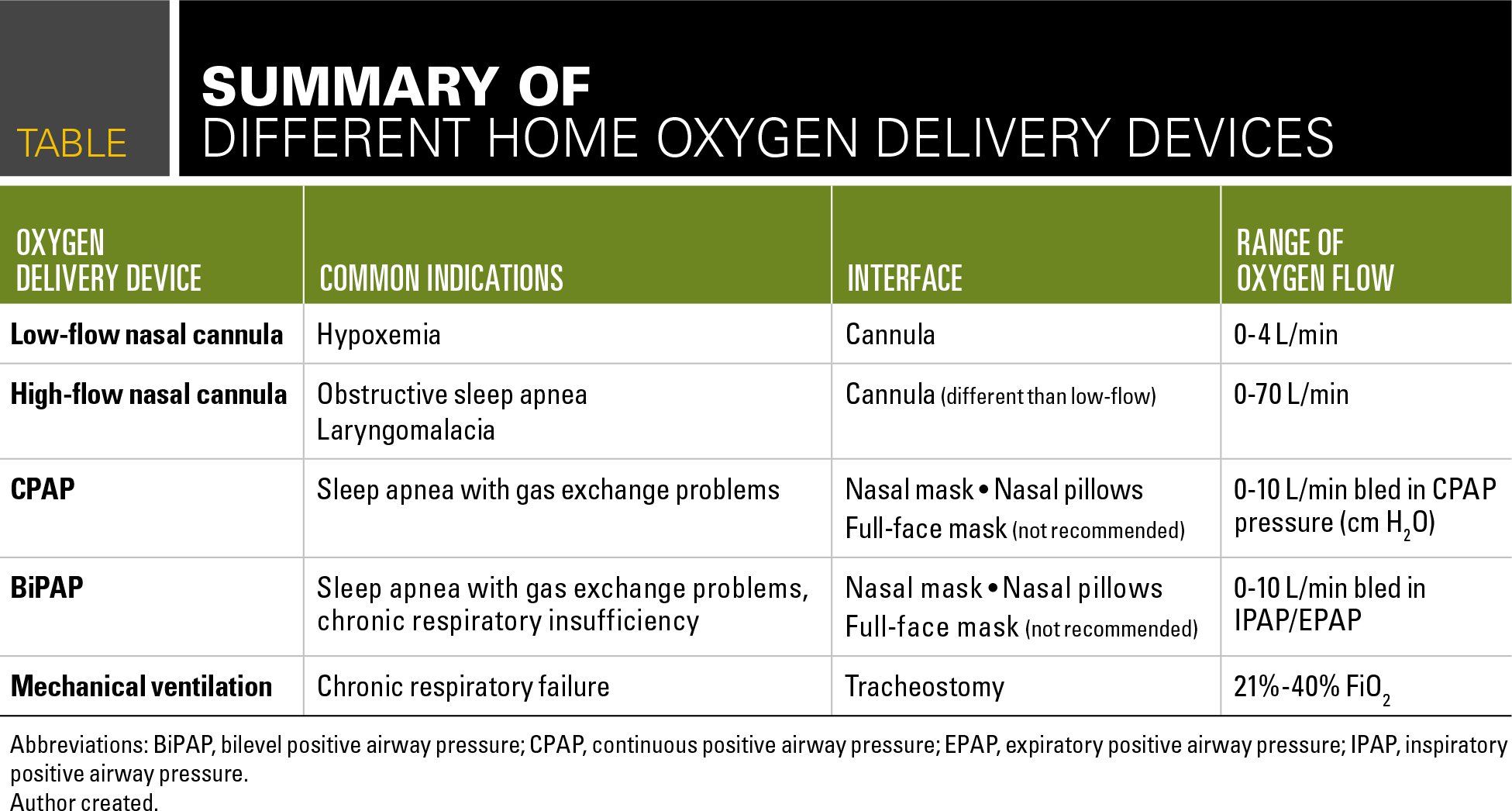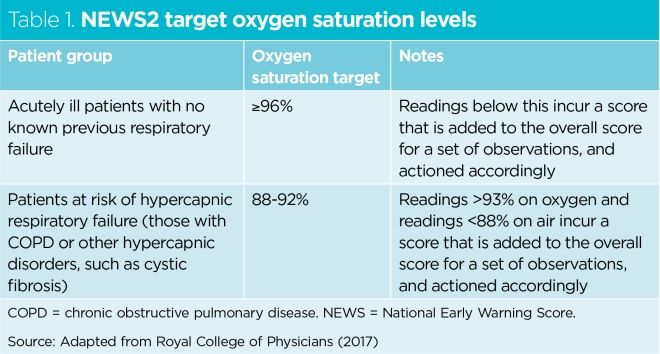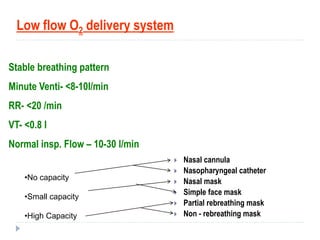oxygen delivery devices and flow rates uk
1 to 6 liters. These devices deliver a variable inspired oxygen concentration to the patient which depends on the PIFR.
Oxygen delivery device Oxygen flow rate.

. Very commonly used among the Oxygen Delivery Devices in wards. Delivers 25 to 40 oxygen at flow rates of 1 to 6 liters per minute. Hudson mask Teleflex Medical 56.
Ensure adequate clearance of secretions and limit the adverse events of hypothermia and insensible water loss by use of optimal humidification dependent on mode of oxygen. It is NOT the Lmin stated on the venturi that is delivered to the patient. Higher flows 4 Lmin make it uncomfortable for the patient.
The nasal cannula is a device that has two prongs that are placed in the patients nostrils and deliver oxygen at flow rates of 1 to 6 liters per minute. Oxygen saturation and delivery system including flow rate should be recorded on the patients monitoring chart. Nasal cannulae Teleflex Medica 1.
1L 24 2L 28 3L 32 4L 36 5L 40 6L 44. Low flow O2 delivery device 05-6 Lmin. Delivers unpredictable oxygen concentrations between 22-35 that vary with flow rate and respiratory pattern and rate.
Oxygen delivery device Oxygen flow rate. Low flow device Most common device used for mild hypoxia Can be set between 1 and 6 LPM 24 to 40 FiO2 FiO2 increases approximately 4 with each liter of O2 KorupoluR GJ Needham DMContemporary CriticalCare. In these situations supplemental oxygen can be administered via various oxygen delivery devices ranging from nasal prongs to invasive ventilation.
Simple Oxygen Face mask. 22 to 60 oxygen with appropriate oxygen flow rates of 05 to 2 Lminute. Adapters deliver set amounts of FiO2 at 24 to 60.
Oxygen delivery by TTOC bypasses the anatomical dead space in the upper airways and mouth allowing oxygen to pass directly into the trachea. Oxygen flow through a TTOC ranges between 05 and 4 Lmin 1. Depending on a patients inspiratory effort tidal volume speed of inspiration and respiratory rate the PIFR can often exceed the flow rate at which oxygen or an oxygenair mixture is supplied by the.
This article presents an overview of oxygen devices oxygen concentrators compressed gas cylinders and liquid oxygen and delivery systems high- and low-flow. Prompt clinical assessment is required if oxygen therapy needs to be initiated or increased due to a falling saturation level. This video - produced by students at Oxford University Medical School in conjunction with the faculty - demonstrates how to deliver oxygen therapy through va.
A simple face mask can deliver 35 to 60 oxygen with an appropriate flow rate of 6 to 10 Lminute. Designed to entrain a set amount of O2 and air which combine to produce a set flow of O2 the stated on the venturi. Nasal cannula Simple plastic tubing prongs with an over the ear adjustments.
Different devices tolerate different flow rates 0-15LminThis flow rate can be set on the wall tap. The of oxygen delivery depends on the flow rate and the delivery device. Nasal Cannula 1-6 litersminute 25-50 Humidifier recommended for all flow rates 4 litersminute High Flow Nasal Cannula 1-15 litersminute 25-50 High.
The oxygen flow rate and the FiO2. Use for non-acute ward use or if mildly hypoxic. There are two important things to consider when delivering supplemental oxygen to your patient.
Hudson mask Delivers 30-40. 200969111 Bailey P Thomsen GE Spuhler VJ et alCrit Care MedJan2007351139145. Give oxygen therapy in a way which prevents excessive CO 2 accumulation - ie.
Oxygen Delivery Devices Delivery Device Minimum to Maximum Liter Flow Range Adults Approximate O2 Delivered Notes RT assistance recommended for liter flows of 6 litersminute or more. Reduce the work of breathing. Also known as Mary Carterall mask.
Start studying EMT - O2 delivery tanks rates and masks. 2 flow rates of less than 2 L O 2 lmin or if minute ventilation is very high 4 Lmin of oxygen flow delivers an FiO 2 of about 03504 providing there is a normal respiratory pattern Flow rates greater than 8Lmin do not increase FiO 2. The oxygen flow rate is the number that we dial up on the oxygen flow metre usually between.
Hudson Nonrebreather Teleflex Medical 1012 80100. Oxygen delivery devices and flow rates should be adjusted to keep the oxygen saturation in the target range. Flow 5ltmin is less tolerated due to flow jet in nasal cavity 1 - 24 2 - 28 3 - 32 4 - 36 5 - 40 6 - 44.
1-2 with every increase in o2 flow per litre. Per minute will deliver approximately 24. Lmin 1 Resultant oxygen concentration.
Nasal cannula Delivers 24-30. Depending on a patients inspiratory effort tidal volume speed of inspiration and respiratory rate the PIFR can often exceed the flow rate at which oxygen or an oxygenair mixture is supplied by the device meaning that at the time of PIFR. A minimum of 6 Lminute of oxygen flow is needed 2to prevent rebreathing of exhaled carbon dioxide.
Selection of the appropriate flow rate and delivery device. Delivers 24 to 50 oxygen at flow rates of 3 to 15 liters per minute. Can be used in patients with stable Type II respiratory failure.
2 to 15 Lmin. 2 A simple face mask is a low-flow oxygen device. These low flow Oxygen Delivery Devices are variable performance devices ie their performance is effected by changes in patients tidal volume and respiratory rate.
Hudson Nonrebreather Teleflex Medical 1012 80100. Sizing available for adults children and infants. Flow rates of 2-4 litresmin are normally used.
Only goes up to 60 FIo2 so not for patients who have significantly high oxygen demands bulky. Can delivery precise and dependable FiO2. Delivers 50 to 60 oxygen at flow rates of 8 to 12 liters per minute.
Oxygen use has extended from inpatient to outpatient settings for patients with chronic pulmonary diseases and complications of hypoxaemia.

Types And Characteristics Of Oxygen Delivery Devices Download Table

Oxymask Versus Traditional Oxygen Devices Download Table

Types And Characteristics Of Oxygen Delivery Devices Download Table

Oxygen Delivery Devices Ati Flashcards Quizlet

High Flow Oxygen In Anaesthesia And Critical Care Wfsa Resources
Clinical Guidelines Nursing Oxygen Delivery

Oxygen Delivery Devices Chapter 10 Diagram Quizlet

Covid 19 And O2 Therapy Initial Prehospital Approach In Mild Symptomatic Patients Medest
Clinical Guidelines Nursing Oxygen Delivery

Oxygen Delivery In The Home Setting

Ensuring The Safe Use Of Emergency Oxygen Therapy In Acutely Ill Patients Nursing Times
Clinical Guidelines Nursing Oxygen Delivery
Mitchell Home Medical Referral Help
High Flow Nasal Cannula Oxygen Therapy Hfnct For Infants And Children Not For Use In Nicu




